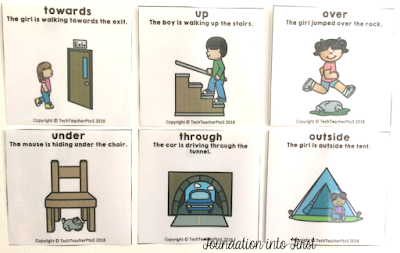Understanding how to use prepositional language is a fundamental skill children require for a number of curriculum subjects such as Maths and English, but the place where this skill is required the most is in the subject of Geography.
Last fortnight I discussed how to teach the concepts of special places and today I want to build on that blog post to discuss the importance of prepositional language in map making.
In the Australian HASS curriculum, Foundation students are required to discuss and map the features of special places using prepositional language and in Year 1 students need to label and map places using directional language. So a solid understanding of prepositional words and their use is essential before you can begin map making.
A good test of your students' understanding of prepositional language is the Drawing Game. This is always a good warm-up as well, before starting your Geography lessons.
Students take a blank piece of paper and follow each instruction you give them (give them slowly so they have processing time).
- Draw a sun in the top left-hand corner
- Draw a hill in the middle of the paper
- Draw a house on top of the hill
- Draw a road below the hill
- Draw a flower in front of the house
- Draw a cat next to the flower
- Draw a bee in between the flower and the cat
And keep going to cover any new prepositional words you might want to use that day. When done, review student work and see who is the good listener and who doesn't know their prepositional words (listening is also a skill required for following prepositional directions).
You can make all sorts of fun games with prepositions such as using the Prepositional Flash Cards (found in my store) to play a very funny classroom game. Give a student a soft toy (or any object but soft toys look funnier) and then pull out a prepositional flash card and the student must demonstrate the preposition with the toy. So you may pull out 'in between' and the student has to place the soft toy in between themselves and another student, 'on top' they might place it on their head!
Once your students are familiar with prepositional words, then move on to some Prepositional Activities such as the sentence pull through (also available in my store). Get students to practice creating and working with sentences with prepositional words in them.
Now the ground work for prepositions has been done, you can move on to map making. Begin with front view (birds-eye view is harder to explain at this point but you can move on to more advanced map making later, but the purpose just now is to understand the reason you make maps; to state where objects are).
As with all subjects, move from what the student knows and understands to the unknown. So begin with mapping the classroom, the most familiar place to your students. Start by brainstorming the features of the classroom and move to mapping out those features on your whiteboard.
After the classroom, you can move to your discussion of special places (grab my freebie in my last blog post) and move to the school playground. You can take map making further by discussing what makes this place special and build upon this with a daily writing task.
Lastly, get students to demonstrate what they have learnt by getting them to map a place very familiar to just them... their bedroom! This is a great homework task and will really let you see what they can do with their map making. If parents do decide to help students at home, this is a double bonus as they can reinforce the skills they have learnt and see what their child is capable of doing on their own.












Thankyou For with wonder full Attractive article as China vacation Is Very Best For enjoyment
ReplyDelete